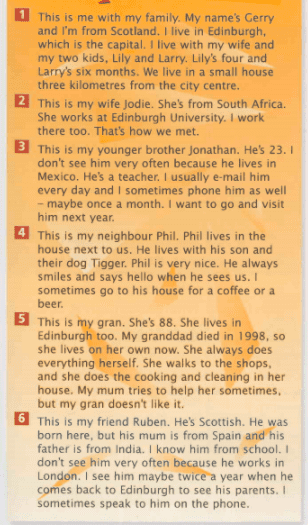Teaching the present simple and present continuous tenses – the hassle of it all
When teaching the present simple and present continuous tenses, many state school English teachers are restricted to using coursebooks.
Traditional syllabus writers tend to linearly group the present simple and present continuous tenses together. First of all, teachers have to cover the present simple. Then, they move on to the present continuous. Finally, pupils have to fill in some mixed practice gap-fill exercises to decide which of the two tenses to use in certain contexts.
For nigh-on fifteen years, I’ve heard Polish students mix up the present simple and present continuous tenses. Actually, the main issue perhaps doesn't revolve around students confusing these tenses. Many Polish learners of English are completely reliant on -ing forms. They use -ing forms when they should use the present simple and past simple tenses.
I ask teachers to use their common sense when teaching the present simple and present continuous tenses. Of course, teachers can't get away from following set syllabuses and curricula. However, they shouldn’t have to be so devoted to teaching -ing forms to their pupils.
WHO’S TO BLAME FOR STUDENTS WHO MUDDLE UP THE PRESENT SIMPLE AND PRESENT CONTINUOUS tenses?
In the Polish context, who’s guilty for all those students who mix up the present simple and present continuous aspects? Well, the blame lies right across the board.
First of all, the Ministry For Education is guilty for authorising traditional and outdated structural syllabuses. Second, let’s not forget all those syllabus writers who live in their heads and can’t move away from tradition. Thirdly, let’s do away with all those Heads of Departments for Foreign Language Education who euphorically celebrate every English language syllabus that comes their way. Finally, some of the blame lies with English language teachers. Many of them instruct in a way that was completely opposite to the methods they used themselves to learn English.
Regarding the grammatical syllabus, I believe that teachers should avoid presenting tenses and grammar items to students according to their perceived level of difficulty. The verb ‘be’, followed by the present simple and present continuous, tend to dominate the opening points of most English language syllabuses around the world. Well, the present simple may look easy on paper. However, so many students use the present continuous in its place.
Disgustingly, Polish school pupils repeat present simple versus present continuous gap fill exercises year after year. Even at the age of sixteen, most of them still can’t produce these aspects when in full conversational flow.
Hence, to our mini gap fill exercise:
1. My father always ________ TV after work (watch)
After three years of nonsensical training, most students will quite rightly put watches in the gap. When in conversation, however, they might say “My father always watching …” or “My father is always watching ... “
WHY DO STUDENTS KEEP MIXING UP THE PRESENT SIMPLE AND PRESENT CONTINUOUS tenses?
The answer is in the question.
Teaching the present simple and present continuous in tandem confuses students.
My experience tells me that:
1. Teachers overload students with exercises on the present continuous. This is an aspect that requires little attention as it’s so rarely used in conversation;
2. Instructors overload students with gap fill exercises. With such exercises, students have to decide whether a present simple form or present continuous form goes into each space;
3. From a very young age, students of English form an unhealthy habit regarding the use of “I’m”. They learn to use “I’m” with adjectives and “I’m” with the present continuous. This sends a message to the brain that they should use “I’m” in more or less all contexts.
Don’t get me wrong. Some teachers work wonders with young kids. However, many of them get the wrong end of the stick when it comes to the present continuous. In essence, they like teaching the present continuous to young kids because it’s fun. I mean: “The monkey is jumping on the table”. “The dog is barking at a tramp”. “The boy is running in the garden”. Unfortunately, such linguistic joviality has the potential to damage students’ control over grammar and inability to retrieve the correct tense when speaking English in years to come. For many students of English, incorrect linguistic features become a permanent part of their spoken language range. This process is known as fossilisation.
HOW SHOULD INSTRUCTORS GO ABOUT TEACHING THE PRESENT SIMPLE AND PRESENT CONTINUOUS tenses?
My plan for teaching the present simple and present continuous tenses is quite straightforward. In essence, do not teach the present continuous to children and teenagers at all.
In my view, the present continuous shouldn’t be introduced to pupils before they reach the age of fifteen. Let’s be honest, we use the present simple far more than the present continuous. We want kids to talk about their families and hobbies - in the present simple. Furthermore, it's a great idea for them to talk about their routines - in the present simple. Why throw a spanner in the works and dish out ridiculous exercises on the present continuous?
How often do people use the present continuous in the real world? Well, not very often. Sure, when you call somebody up, you might ask: “What are you doing?” The receiver might respond something like “Oh I’m just doing my emailing”. Overall, such rare use of a grammar item does not justify kids wasting so many years at school doing fruitless gap fill exercises.
The most dedicated eighteen-year-old Polish students of English continue to make the same old verbal bloopers with the present simple and present continuous. Hence, the grammatical syllabus which dominates the teaching landscape of Polish schools requires some serious scrutiny and revision.
HOW CAN STUDENTS MASTER THE PRESENT SIMPLE AND RETRIEVE IT AUTOMATICALLY IN REAL LIFE CONVERSATIONS?
When it comes to teaching the present simple and present continuous aspects, the name of the game is giving pupils the freedom to personalise grammar structures.
Personal accounts like the ones below are perfect for pupils to read over and over again:

Source: see below
With regard to these short texts, students should be encouraged to use as many of the sentences in the present simple as they can to tell true stories about themselves or close relatives.
Sentences and sentence parts in the present simple which are ideal for personalised speaking:
- I live in …
- I live with my wife
- We live in a small house …
- She works at …
- I don’t see him/her very often because …
- I usually email him every day
- He lives in the house next to us
- I sometimes go to his house for a coffee or a beer
- She lives on her own
- She walks to the shops
- I sometimes phone him as well
- She does the cooking and cleaning
- He works in London
- I see him maybe twice a year
- ... when he comes back to …
Of course, learners can improvise and make slight changes to the sentences to fit their own circumstances.
Here’s how I could exploit the sentences above to speak about my own personal situation:
I live in Gdańsk, which is in the north of Poland. I live with my wife in a fairly large flat three kilometres from the Old Town. I tend to do the shopping and hoovering, while my wife does the cooking and ironing.
Final Thoughts
All in all, enabling learners to tell true stories about themselves using the present simple helps them to internalise the structure and think in English. What's more, there’s no harm in getting students to retell these stories every so often.
Source for screenshot:
Dellar, H., and Walkley, A. 2005. Innovations Elementary, First Edition, Heinle ELT



